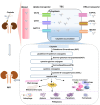Acute kidney injury: pathogenesis and therapeutic interventions
- PMID: 40911105
- PMCID: PMC12413393
- DOI: 10.1186/s43556-025-00293-4
Acute kidney injury: pathogenesis and therapeutic interventions
Abstract
Acute kidney injury (AKI) is a prevalent clinical condition that is associated with unacceptably high morbidity and mortality, as well as the development of chronic kidney disease (CKD). The pathogenesis of AKI is highly complex and heterogeneous, primarily attributed to metabolic disturbances arising from the disease itself and the administration of medications related to treatment. In recent years, AKI in cancer patients is highly concerned. The emergence of AKI caused injuries and dysfunction of remote organs but also enhanced the health-care costs. It's essential for early recognition of AKI by biomarker or prediction models and further, take a timely intervention. This review aims to provide the pathophysiology of AKI covering the intricate mechanisms underpinning AKI in the dynamic context of the clinical setting, the tailored role of inflammation and ischemia, and the cellular and molecular crosstalk pathways involved. These events closely related to patients at high risk of AKI and underscore the characteristics that may make these patients more susceptible to injury. Furthermore, the diagnosis of AKI relies on clinical criteria, biomarkers, and imaging, but it should be distinguished from CKD. Finally, the review offers the therapeutic intervention in clinical practice and preclinical or clinical trials, focusing on the improvement of conventional therapy and advanced novel treatment strategies. Simultaneously, the challenge and future direction on early identifying renal impairment and performing renoprotection are also discussed, further supporting the novel discipline including onco-nephrology. The development of effective interventions that reduce nephrotoxicity is highly contingent upon a thorough understanding of the molecular pathophysiology of AKI.
Keywords: Acute kidney injury; Diagnosis; Pathophysiology; Risk; Therapy.
© 2025. The Author(s).
Conflict of interest statement
Declarations. Ethics approval and consent to participate: Not applicable. Consent for publication: Not applicable as no patients/participants were involved in this review. Competing interests: All authors state that there are no potential competing interests.
Figures






Similar articles
-
Prescription of Controlled Substances: Benefits and Risks.2025 Jul 6. In: StatPearls [Internet]. Treasure Island (FL): StatPearls Publishing; 2025 Jan–. 2025 Jul 6. In: StatPearls [Internet]. Treasure Island (FL): StatPearls Publishing; 2025 Jan–. PMID: 30726003 Free Books & Documents.
-
Management of urinary stones by experts in stone disease (ESD 2025).Arch Ital Urol Androl. 2025 Jun 30;97(2):14085. doi: 10.4081/aiua.2025.14085. Epub 2025 Jun 30. Arch Ital Urol Androl. 2025. PMID: 40583613 Review.
-
Systemic Inflammatory Response Syndrome.2025 Jun 20. In: StatPearls [Internet]. Treasure Island (FL): StatPearls Publishing; 2025 Jan–. 2025 Jun 20. In: StatPearls [Internet]. Treasure Island (FL): StatPearls Publishing; 2025 Jan–. PMID: 31613449 Free Books & Documents.
-
Erythropoiesis-stimulating agents for preventing acute kidney injury.Cochrane Database Syst Rev. 2024 Sep 20;9(9):CD014820. doi: 10.1002/14651858.CD014820.pub2. Cochrane Database Syst Rev. 2024. PMID: 39301879
-
Neutrophil gelatinase-associated lipocalin (NGAL) as biomarker of acute kidney injury: a review of the laboratory characteristics and clinical evidences.Clin Chem Lab Med. 2012 Feb 15;50(9):1505-17. doi: 10.1515/cclm-2011-0814. Clin Chem Lab Med. 2012. PMID: 22962216
References
-
- Ostermann M, Lumlertgul N, Jeong R, See E, Joannidis M, James M. Acute kidney injury. Lancet. 2025;405(10474):241–56. 10.1016/S0140-6736(24)02385-7. - PubMed
-
- Patidar KR, Ma AT, Juanola A, Barone A, Incicco S, Kulkarni AV, et al. Global epidemiology of acute kidney injury in hospitalised patients with decompensated cirrhosis: the International Club of Ascites GLOBAL AKI prospective, multicentre, cohort study. Lancet Gastroenterol Hepatol. 2025;10(5):418–30. 10.1016/S2468-1253(25)00006-8. - PubMed
-
- Bellomo R, Ronco C, Kellum JA, Mehta RL, Palevsky P, Acute Dialysis Quality Initiative w. Acute renal failure - definition, outcome measures, animal models, fluid therapy and information technology needs: the Second International Consensus Conference of the Acute Dialysis Quality Initiative (ADQI) Group. Crit Care. 2004;8(4):R204–12. 10.1186/cc2872 - PMC - PubMed
Publication types
MeSH terms
Substances
Grants and funding
LinkOut - more resources
Full Text Sources
